Exploring the Behaviors of River Otters


Overview of the Topic
Foreword to River Otters
River otters are fascinating mammals known for their playful behavior and adaptability. As members of the weasel family, these creatures thrive in a variety of habitats, from freshwater rivers to coastal areas. Understanding their behavior goes beyond mere observation; it involves looking into the intricate web of social interactions, communication methods, and environmental adaptations. The role river otters play in their environment is not just of academic interest; it is crucial for maintaining the balance of ecosystems.
Why River Otter Behavior Matters
The investigation into river otter behavior has significant implications for conservation efforts. These animals are considered indicators of environmental health, so studying them can provide insights into the state of their ecosystems. Additionally, understanding their behavior helps in formulating effective conservation strategies to protect not just the otters but also the myriad of species that share their habitat.
Current Status and Challenges
Present Condition of River Otter Populations
Currently, river otter populations are witnessing both recovery and decline in various regions. While certain areas have seen a rebound due to conservation initiatives, others face threats from habitat loss, pollution, and climate change.
"River otters serve as vital components of their ecosystems, impacting both flora and fauna through their predation and foraging habits."
Key Challenges Facing River Otters
- Habitat Degradation: Urban development and agriculture can disrupt river otter habitats. Wetlands, which are critical for their survival, continue to face threats from draining and pollution.
- Pollution: Contaminants in water bodies affect the health of river otters, leading to declines in their populations.
- Climate Change: Changes in climate patterns can affect the availability of prey and suitable habitats, which are essential for otter populations to thrive.
Sustainable Solutions
Practical Approaches for Conservation
Efforts toward sustainable management of river otters involve a multi-faceted approach. Restoration of wetlands, implementation of pollution control measures, and habitat preservation initiatives are vital.
Successful Implementations
Case studies such as the restoration of the Chesapeake Bay demonstrate that focused conservation strategies can rejuvenate local otter populations. Community-driven conservation, where local populations engage in habitat protection, has shown outstanding results.
- Community Engagement: Local communities play a significant role in conservation efforts. Initiatives such as river cleanups or habitat restoration projects can have a lasting impact.
- Legislation: Strong laws protecting aquatic habitats are essential to safeguard the lifeline of the river otters.
Impact and Importance
Influence on Ecosystems
The significance of river otters extends beyond their charming appearance. They have a direct effect on the populations of fish and invertebrates, thereby maintaining ecological balance. Their hunting maintains the health of aquatic ecosystems by controlling prey populations, promoting biodiversity.
The Conservation Imperative
For future generation, preserving river otter populations is crucial for the rich biodiversity of their habitat. Conservation efforts not only help otters but also ensure that entire ecosystems remain intact and thriving. Through education, legislation, and habitat protection, a sustainable future for river otters—and the environments they inhabit—can be achieved.
Prolusion to River Otters
River otters are more than just playful mammals we might catch a glimpse of along riverbanks; they embody remarkable adaptations that allow them to thrive in diverse aquatic ecosystems. Understanding their behavior is crucial not only for the conservation of river otters themselves but also for the health of the habitats they occupy. This section serves as an essential foundation for exploring the different facets of river otter life, including social structures, communication, and their ecological roles.
Definition and Classification
River otters belong to the family Mustelidae, which includes a variety of other carnivorous mammals, such as weasels, badgers, and ferrets. Scientifically known as Lontra canadensis, they are part of a genus that showcases a variety of otter species. Generally, these animals are characterized by their streamlined bodies, webbed feet, and thick fur, which suits them for life in the water. Their classification underlines their significant ecological role and sheds light on their behavior and interactions with other species.
Natural Habitat and Distribution
River otters usually prefer habitats that provide them both aquatic and terrestrial needs. They are often found in freshwater lakes, rivers, and coastal areas of North America. Their distribution spans wide geographical areas, from Alaska to the Gulf of Mexico. They favor habitats with abundant cover, whether that be dense vegetation along banks or rocky shorelines where they can hide from predators.
Their adaptability is evident since they can also survive in urban areas if sufficient resources are available. The presence of river otters often indicates a healthy ecosystem; thus, protecting their natural habitats is imperative.
"River otters can traverse both land and water, which showcases their versatile lifestyle. Their behaviors are directly influenced by their surroundings, making habitat preservation a priority in conservation efforts."
By exploring the definition, classification, and habitats of river otters, readers will appreciate the significance of these creatures in aquatic ecosystems and understand the importance of their conservation.
Physical Characteristics of River Otters
Understanding the physical characteristics of river otters is crucial for comprehending their behavior, habitat use, and ecological roles. This section sheds light on how their size, weight, and unique adaptations make them well-suited for aquatic environments. Getting to grips with these traits not only informs conservation efforts but also enriches our appreciation of these fascinating mammals.
Size and Weight
River otters are striking animals, usually measuring about 2 to 3 feet in length. When you add the tail—which typically accounts for about a third of their total length—they can seem rather elongated. Adult river otters can weigh anywhere from 50 to 100 pounds, although the exact figures depend on their environment and food availability. Female otters tend to be smaller than their male counterparts, a common trait seen in wildlife.
Their size and weight play a significant role in their survival and behaviors. A larger otter is often a better swimmer, able to navigate swift currents in rivers. The extra weight not only helps with buoyancy but also provides insulation against cold water.
"The weight of a river otter helps maintain warmth and provides energy to dive deep, search for prey, and readily adapt to seasonal changes in their habitat."
Adaptive Features
River otters possess various unique adaptive features that enhance their fitness in aquatic environments.
- Webbed Feet: These otters have webbed toes that act like paddles, empowering them to maneuver efficiently through water while swimming. This adaptation is vital for foraging and escaping from predators.
- Streamlined Bodies: Their elongated and streamlined physique means less resistance as they swim, allowing them to glide. This body shape also facilitates rapid dives when hunting.
- Thick Fur and Blubber: A double-layered coat traps air for insulation, providing heat retention in chilly waters. This thick fur means they can stay submerged longer in cold temperatures without succumbing to hypothermia.
- Muscular Tail: A powerful tail is another noteworthy adaptation. It not only assists with steering in the water but also functions as a rudder, increasing their agility during swift movements.
In addition to these physiological features, river otters have developed excellent senses, particularly their vision and hearing, assisting them in hunting and communication.
The combination of these physical characteristics makes river otters exemplary survivors within their habitats. To really appreciate their role in the ecosystem, one must understand how these traits align with their behavior, diet, and interaction with their environment.
Social Behavior and Structure
Social behavior and structure are vital aspects of understanding river otters and their complex interactions within their environments. Recognizing how these creatures form societies can provide valuable insight into their ecological roles and underline the importance of conserving their habitats. River otters are social animals that exhibit fascinating behaviors, engaging in playfulness and cooperation, which are important for their survival.
Social Groups and Family Units
River otters typically live in groups called rafts, primarily consisting of family members. A raft commonly includes a female, her offspring, and sometimes other related females. This social structure offers several advantages:
- Cooperative Hunting: By working together, otters increase their chances of successful hunting. They can create diversions that help them corral fish or other prey, making it easier for each member to catch food.
- Parental Protection: Mothers provide direct care to their young, but the presence of other family members helps ensure the safety of the pups. With multiple adult otters around, potential threats—like predators—are less likely to succeed.
- Learning Opportunities: Young otters learn important skills from watching and interacting with adults and siblings. This social learning enriches their experience and helps them effectively adapt to their surroundings.
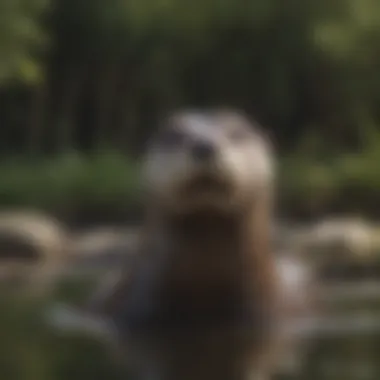
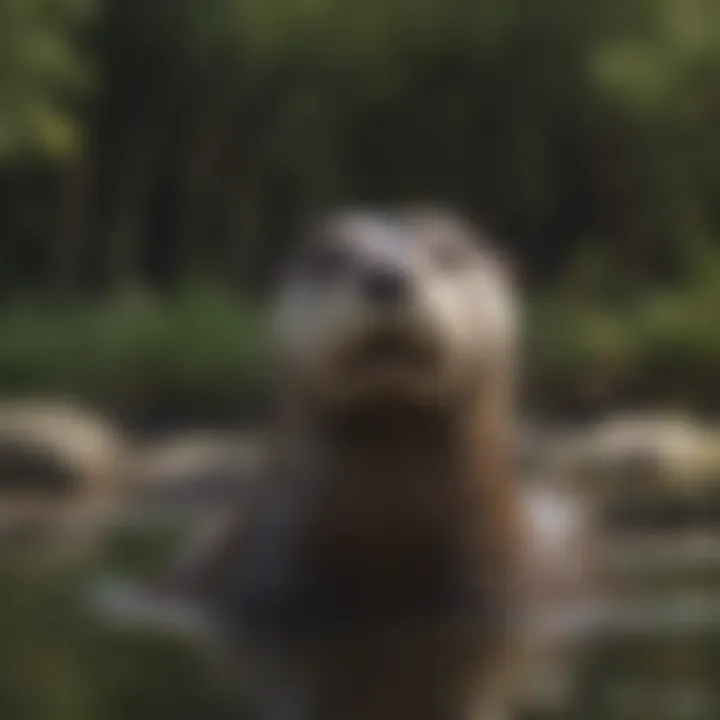
Unlike many solitary animals, otters thrive in the company of their family units, which enhances their survival rates and enables better adaptation to changing environments. The cooperative nature of their social structure is instrumental for their long-term success.
Hierarchy and Interactions
Within these family units, river otters maintain a certain hierarchy, which dictates their interactions and roles. Dominance doesn't often rely on size or aggression; it is more about established relationships and mutual respect among the otters involved. This dynamic plays out in several ways:
- Leadership Roles: Generally, the mother, being the primary caregiver, holds the highest status within the group, as she leads them in hunting and provides guidance for her young. This role extends beyond mere oversight; it also involves teaching the young how to navigate their environment.
- Social Interactions: River otters frequently engage in grooming behaviors, which strengthen bonds between them. Grooming serves to reinforce social ties and allows individuals to communicate comfort and trust.
- Conflict Resolution: Occasionally, disputes may arise—perhaps over food or resting places—but these conflicts are often resolved through playful antics rather than aggressive confrontations. Such responses help maintain cohesion within the group.
Strong social links enhance the resilience of river otters, allowing them to better face environmental changes and threats. The presence of social support systems is crucial for their overall survival.
In summary, the social behavior and structure of river otters reflect their adaptability and resilience in their aquatic environments. Understanding their social dynamics not only emphasizes their need for conservation but also sheds light on the intricate fabric of interactions that characterize their daily lives.
Communication Among River Otters
Communication among river otters is crucial for fostering social bonds, coordinating activities, and navigating their environments. These playful mammals possess a rich array of vocalizations and body language, each serving a distinct purpose in their daily interactions. By understanding their communicative behaviors, we can further appreciate the complexity of their social structures and their adaptability to different environmental circumstances.
Vocalizations and Sounds
River otters are known to be quite vocal animals, using sounds to express a variety of emotions and intents. The chorus of playful squeaks, growls, and chirps fills the air when they frolic and chase each other. These sounds are not just random noises; they play a significant role in socialization and coordination. For instance:
- Alert Calls: These sharp, high-pitched sounds signal danger. When one otter senses a threat, it can quickly alert the others, promoting group safety.
- Playful Vocalizations: During play, their sounds can range from playful chirping to more excited barks. These vocalizations are a way to initiate play and maintain engagement, strengthening bonds between family members.
- Mating Calls: During the breeding season, males may vocalize to attract females, demonstrating their fitness and readiness.
These vocalizations form a vital part of the otters’ communication repertoire, making it easier for them to coordinate and thrive in their environment.
Body Language
Body language among river otters is as expressive as their vocalizations, conveying a wealth of information without uttering a single sound. By observing their movements and postures, one can infer various emotional states and intentions:
- Play Behavior: When otters engage in play, they may exhibit specific postures, such as rolling on their backs or jumping in the air. These gestures signal not just enjoyment but also invite others to participate in their antics.
- Defensive Posture: When threatened, an otter might arch its back and elongate its body, a gesture meant to appear larger and more intimidating.
- Social Grooming: Otters often groom each other, which is not just a hygienic practice but also a bonding activity. It shows trust and affection, reinforcing their social ties.
"Observing a river otter’s body language can reveal just as much about its feelings as its vocalizations can. The subtleties in their posture and movements speak volumes about their social dynamics and emotional states."
Hunting and Feeding Behaviors
Hunting and feeding behaviors are crucial aspects of river otter ecology and play a significant role in their survival and health. Understanding these behaviors not only provides insight into the river otter's lifestyle but also reflects their adaptability and ecological significance. As predators in their aquatic habitats, river otters help regulate prey populations, thereby maintaining a balanced ecosystem.
Foraging Techniques
River otters are adept foragers, employing various techniques to secure their meals. They primarily hunt in water but are not shy about coming ashore in search of food. One notable technique involves swimming in a circular pattern, creating disturbances in the water. This method can confuse fish, making them easier to catch. When an otter spots a potential meal, it can swiftly dive, utilizing its nimble body to navigate through the water.
Another important aspect of their foraging is their keen sense of sight and hearing, which contribute significantly to their success. Otters often hunt at dawn or dusk—twilight hours that increase their chances of penetration into the hunting grounds without being detected by prey.
- Diving Depth: River otters can dive up to 60 feet (about 18 meters) underwater, holding their breath for several minutes while searching for food.
- Group Dynamics: Often, otters hunt in groups, which enhances their ability to drive fish into tighter spaces, making them easier to catch.
"By working together, river otters transform a solitary hunt into an intricate performance, showcasing teamwork and communication."
Prey Selection
The diet of river otters is versatile, heavily influenced by their habitat and the availability of prey. They predominantly feast on a rich assortment of fish, crustaceans, and even small mammals. Some common prey include:
- Fish: Trout, salmon, and catfish are favorites due to their abundance in freshwater habitats.
- Crustaceans: Crayfish and crabs provide a nutritious and accessible food source, especially in coastal areas.
- Amphibians: Frogs and salamanders occasionally make it onto the otter's menu, offering variety and necessary nutrients.
River otters tend to favor prey that is easy to catch, which leads them to select less mobile species. However, they are also known to adapt their diet based on habitat changes and food scarcity. During lean seasons, they can switch to alternative prey types, exhibiting remarkable resilience.
Their hunting strategies and prey selection are not just about individual survival but are linked to the larger environmental framework. By preying on certain species, otters influence the dynamics of populations in aquatic ecosystems, showcasing their integral role in ecological health.
Reproductive Behavior
The reproductive behavior of river otters is not just about ensuring the continuation of their species; it also provides insight into their social structures and environmental adaptability. Understanding how these creatures mate and raise their young can illuminate many aspects of their health as a population and their role within the ecosystems they inhabit. Within the context of river otters, reproductive activities demonstrate the balance of parental investment and survival strategies, which are crucial for their overall success in the wild.
Mating Rituals
Mating season for river otters typically occurs in late winter or early spring. These mammals engage in a series of elaborate rituals that can last several weeks. The animals often perform a combination of vocalizations, rolling on the ground, and playful water displays to attract a mate. This courtship dance is an essential part of their bonding process, building trust and reinforcing social ties.
During these rituals, males may be seen following females closely, often engaging in playful sparring as part of the courtship process. This behavior not only displays fitness—the males showing their strength and agility—but also helps females assess potential mates. It's fascinating how the social dynamics can influence reproductive success, where the strongest and most adaptable otters tend to secure mates and contribute to a robust gene pool.
Parental Care and Offspring Development
Once mating has occurred, the gestation period lasts about two months, and females typically give birth to two to three kits. However, factors like environmental conditions and food availability can affect litter size. The care that females provide for their young is extensive and multifaceted.
Key aspects of parental care include:
- Nurturing: Mothers nurse the kits for several months, providing essential nutrients critical for their growth.
- Education: As the kits grow, mothers teach them important survival skills including hunting and swimming, essential for living in aquatic environments.
- Protection: The mother is fiercely protective; she will expertly hide her young in safe dens to shield them from predators. This strategic behavior ensures a higher survival rate during the vulnerable early stages of life.
The development of the kits is gradual, with eyes opening at around two weeks and solid food introduced when they are about two months old. Their playful nature during this stage is not mere fun; it plays an integral part in their development, as they learn valuable lessons in social interaction and hunting techniques.
"The nurturing behaviors of river otter mothers signify a deep-rooted instinct to ensure not just survival, but also social competence in the offspring."
Through these detailed and instinctual practices, river otters reflect a broader ecological balance, highlighting the complexities of life in diverse environments. Their reproductive behavior exemplifies the tight-knit relationships and adaptability required to thrive in changing conditions.
Swimming and Diving Techniques
River otters are renowned for their impressive swimming and diving abilities, which play a crucial role in their survival and adaptation to aquatic environments. This section sheds light on how these techniques are not just fundamental to their hunting prowess but also to their social behaviors and interactions with the ecosystem. Understanding** swimming and diving** in river otters offers insights into their daily lives, providing an appreciation for their role in maintaining the health of the waterways.
Swimming Behavior
River otters exhibit a distinctive swimming behavior that reflects their adaptations to an aquatic lifestyle. Their streamlined bodies, covered in a sleek coat of dense fur, are designed to glide effortlessly through water. They can hold their breath for extended periods, usually averaging up to 6 to 8 minutes while submerged, but some individuals have been recorded to stay underwater a bit longer when necessary. This technique is particularly useful when evading predators or hunting for prey.
In addition to this physical adaptation, river otters display an array of swimming styles. For instance, they often swim on their backs, particularly when playing or grooming. This behavior isn’t merely whimsical; it showcases their remarkable agility. They can change direction swiftly with just a flick of their tails, which is essential when navigating through both calm and turbulent waters.
Otters are also social swimmers. It's not uncommon to see them swimming in groups. This social behavior serves multiple benefits:
- Strength in Numbers: Group swimming reduces the risk of predation.
- Hunting Strategies: They often cooperate during hunts, encircling schools of fish or working together to flush out potential prey.
- Playfulness: Social swimming often turns into playful antics, strengthening bonds among individuals.
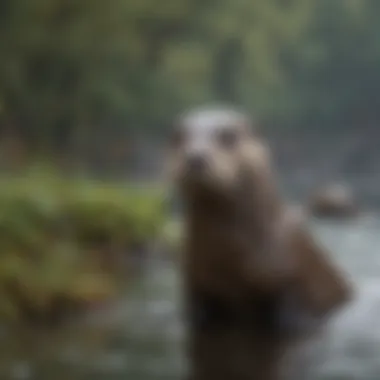
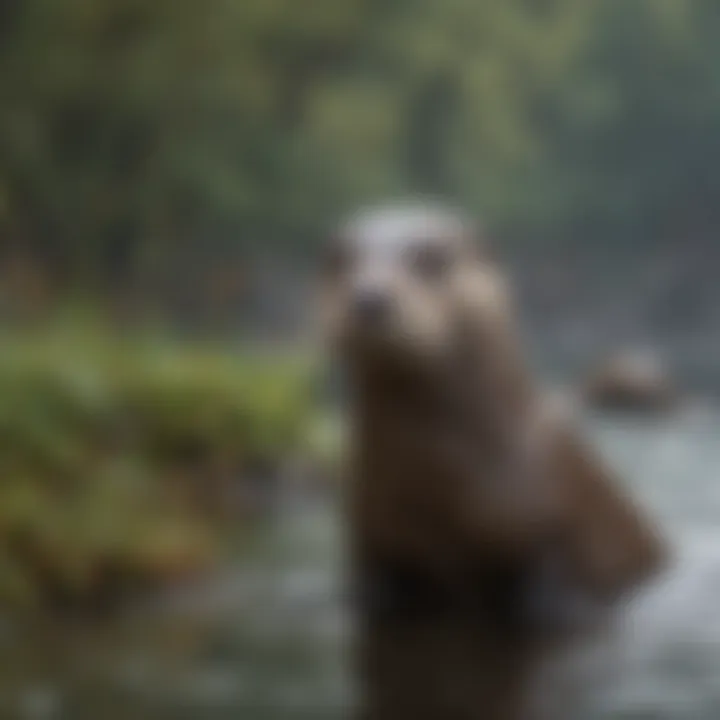
"The river otter is a remarkable swimmer, exhibiting both grace and playfulness as it maneuvers through its aquatic environment, reflecting a balance of survival and social interaction."
Diving Mechanics
Diving is a vital aspect of a river otter’s feeding tactics. They employ various diving mechanics that contribute to their success as hunters. When diving, river otters use a method called the surface dive, which involves a swift push off from the water's surface to reach the depths quickly. Their webbed feet provide the necessary propulsion, allowing them to dart down and cover significant distances underwater.
The mechanics of diving involve more than just physical adaptations. River otters possess excellent visual acuity in low-light conditions, allowing them to spot prey even in murky waters. They rely heavily on their keen eyesight and sensitive whiskers to detect movements, adjusting their dives based on the behavioral cues of their prey.
Additionally, otters demonstrate remarkable breath control when diving. After an active dive, they can quickly return to the surface to replenish oxygen before diving again. This is critical, especially when they are foraging in areas with fluctuating currents.
Another interesting aspect is their ability to perform what could be termed as "dive cycles". They alternate between short bursts of activity and rest periods just beneath the surface, maximizing efficiency while hunting or waiting for prey to come closer. This technique conserves energy and allows them to remain vigilant.
Understanding these swimming and diving techniques of river otters becomes essential not just for appreciating their innate abilities but also for recognizing the impacts of environmental changes on their habitats. As waterways become more polluted or disrupted, the decline in prey species directly affects their survival and behavior, leading to a cascading impact on the entire ecosystem.
Play Behavior in River Otters
Play behavior holds a special place in the world of river otters, acting as a lens through which their social structures and learning processes can be observed. Unlike many animal behaviors that are strictly survival-driven, play brings a refreshing aspect to their daily activities, offering both entertainment and educational benefits. This behavior not only strengthens social bonds but also aids in skill development crucial for foraging and navigation in their aquatic environments.
Social Play and Bonding
River otters are often seen engaging in social play, which is essential for building strong relationships within groups. These interactions can include wrestling, chasing, and rolling on the ground or—often—aided by water, where they can perform flips and dives that showcase their physical agility. When otters play together, it’s not merely spontaneous amusement; it reflects a critical social function.
- Strengthening Bonds: Through these playful activities, otters strengthen their emotional ties within families, fostering cooperation and alliance among siblings and parents.
- Establishing Hierarchies: Play also serves as a method for establishing social hierarchies. In these playful exchanges, younger individuals learn their position in the social order, helping them understand their place in the group dynamic. This is important for future interactions when it comes to mating, foraging, and various activities requiring teamwork.
Play as Learning
The role of play in learning cannot be overstated. For river otters, this behavior is an instinctual element of their development. Young otters can often be found attempting to mimic the actions of adults while at play, whether it be diving techniques or even hunting strategies. This type of play-acting is valuable for several reasons:
- Skill Acquisition: Engaging in playful activities allows young otters to develop the skills necessary for survival, such as swimming effectively and capturing prey. By imitating the more experienced otters, they fine-tune their techniques in a low-pressure environment.
- Risk Assessment: Play also grants young otters the opportunity to engage in risk-taking behaviors which help them learn about limits and personal safety. Smack in the water or a tumble down the riverbank reinforces the understanding of their physical capabilities.
"Play is not just a frivolity for river otters but rather an essential building block for their future well-being and interaction with the world."
- Problem-Solving Skills: As they navigate through playful challenges, otters are not merely experiencing fun; they're honing their cognitive abilities. Tackling obstacles or finding new ways to engage with their environment during play promotes clever problem-solving skills that are important in their natural habitat.
Response to Environmental Changes
Understanding how river otters respond to environmental changes is crucial for several reasons. These changes can impact their survival, reproduction, and overall role within aquatic ecosystems. Exploring these behaviors can reveal insights into how river otters navigate challenges and adapt to shifting conditions in their habitats. Furthermore, by studying their adaptations and vulnerabilities, researchers and conservationists can better spearhead efforts to protect these enchanting creatures and their ecosystems.
Adaptations to Climate Variability
River otters are resilient animals, exhibiting remarkable adaptability to climate variability. As temperatures fluctuate and precipitation patterns shift, river otters actively modify their behaviors to endure these changes. For instance, during warmer months, when water levels potentially drop due to drought, river otters might alter their foraging techniques, utilizing areas with deeper pools or selecting prey that are more abundant in such conditions. They could even adjust their activity periods to cooler times of the day.
Moreover, river otters are known to utilize a diverse range of habitats. From rivers to ponds, and coastal areas, their willingness to exploit different environments aids their survival in the face of climate-induced changes. This adaptability is not just about survival, but it plays into their role as predators in various ecosystems. By shifting their locations or prey, river otters help maintain balance in communities that might be impacted by environmental changes.
Effects of Pollution and Habitat Loss
Pollution and habitat loss pose significant threats to river otters, and the impact is twofold: it disrupts their lifestyle and threatens the broader ecological health of their habitats. Contaminants such as heavy metals and pesticides find their way into water systems, ultimately affecting the fish and other prey that otters rely on. Studies show that polluted water bodies can lead to lower reproduction rates and increased mortality in younger otters.
Habitat loss further compounds these challenges. Urban expansion and agricultural development often lead to fragmentation of otters’ natural environments. When landscapes are altered, otters may find it difficult to navigate, hunt, and even locate suitable dens. This loss of habitat isn’t just an inconvenience; it can lead to decreased genetic diversity and heightened competition among the remaining populations.
"The health of river ecosystems is intrinsically tied to the welfare of their inhabitants, including otters, making conservation efforts essential for broader environmental stability."
In closing, addressing the impacts of pollution and habitat loss demands urgent attention. Sustained conservation initiatives, along with increased public awareness, can serve to protect river otters and their ecosystems. With a finger on the pulse of environmental changes, we have a fighting chance to ensure the well-being of these fascinating mammals for generations to come.
Conservation Status and Efforts
Conservation status and efforts surrounding river otters play a critical role in maintaining their populations and preserving the ecosystems in which they thrive. These efforts not only safeguard the otters themselves but also the broader health of aquatic environments. Understanding the threats faced by river otters, as well as successful initiatives aimed at their conservation, is essential for anyone interested in wildlife preservation, especially those in conservation, environmental studies, or even the casual enthusiast.
Current Threats to River Otter Populations
River otters encounter a myriad of challenges that jeopardize their survival. Here’s a closer look at the specific threats:
- Habitat Loss: Urban expansion, logging, and agriculture disrupt river otters’ natural habitats. Wetlands and waterways, crucial for their ecosystem, are often drained or polluted.
- Pollution: Chemicals and toxins in water bodies adversely affect otter health. Polluted environments lead to bioaccumulation of harmful substances in their food sources.
- Human Interaction: Accidental trapping, hunting, and vehicle strikes present ongoing dangers. While hunting regulations exist, enforcement varies, leading to illegal poaching in some areas.
- Climate Change: Altered rain patterns and extreme weather events impact food availability and breeding season timing, challenging otters’ adaptability.
These threats not only endanger river otters but also ripple through the ecosystems they inhabit, affecting other species and biodiversity.
Successful Conservation Initiatives
Fortunately, various conservation initiatives have shown promise in protecting river otter populations. Some successful strategies include:
- Protected Areas: Establishing wildlife reserves helps safeguard critical habitats. In numerous regions, protected waterways have seen a resurgence in otter populations.
- Rehabilitation Programs: Some organizations have dedicated efforts to rehabilitate injured otters and reintroduce them to their natural environments, ensuring they can thrive in the wild once more.
- Public Education Campaigns: Increasing awareness about the ecological importance of river otters has fostered public support for conservation measures. Programs often engage communities, teaching them how to coexist with wildlife effectively.
- Research and Monitoring: Institutions studying otter behaviors and populations provide data that informs conservation strategies. Ongoing research allows for adapting conservation efforts in real-time.
"Protecting river otters not only ensures their survival but also serves as a barometer for the health of our waterways, highlighting the intricate connections within ecosystems."
In summary, while river otters face several challenges today, proactive conservation efforts are making significant strides in preserving their populations. By understanding these dynamics, conservationists and enthusiasts alike can contribute to ongoing success and foster a healthy environment for future generations.
Ecological Role of River Otters
The ecological role of river otters extends far beyond mere aesthetics. These playful creatures serve as vital components of their ecosystems, contributing to the health of aquatic environments. Understanding their place in nature not only highlights the need for their conservation but also sheds light on how their behaviors impact multiple species and ecological processes.
Impact on Aquatic Ecosystems
River otters are essential for maintaining balanced aquatic ecosystems. They primarily feed on fish, crustaceans, and various invertebrates, playing a significant role in population control of these species. This predation helps prevent any single species from dominating the habitat, thus promoting biodiversity.
- Nutrient Cycling: As otters consume and excrete food, they facilitate nutrient cycling. Their waste enriches the sediments and waters, promoting plant growth and benefiting the lower food web.
- Habitat Regulation: Otters create mulitple pathways in wetlands and river systems as they navigate their environment, contributing to the overall structure of their habitats. These trails often get utilized by other species, adding another layer to the web of life.
- Indicator of Water Quality: The presence of river otters often indicates a healthy aquatic ecosystem. They thrive in clean water environments, making them a crucial indicator species for scientists monitoring environmental health.
"The decline of river otters can signal deeper ecological problems within aquatic habitats, making their conservation vital for overall ecosystem health."
Indicator Species and Their Importance
River otters are considered indicator species. This means their status reflects the health of the environment in which they live. Changes in otter populations can provide important clues about ecosystem stressors, like pollution or habitat degradation.
- Monitoring Ecosystem Health: As top-level predators, river otters are sensitive to changes within their environments. A decline in otter numbers often alerts researchers to potential environmental issues that might also affect other species.
- Biodiversity Benchmarks: Because they rely on diverse aquatic habitats, the presence of robust otter populations suggests overall biodiversity. Protecting river otters indirectly supports many other organisms that share their habitat, leading to a richer ecosystem.
- Community Education: River otters simplify complex ecological concepts for the public. Their engaging behavior and presence can draw attention to conservation efforts, fostering community support for broader environmental initiatives.
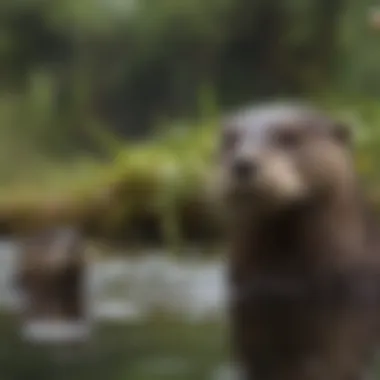
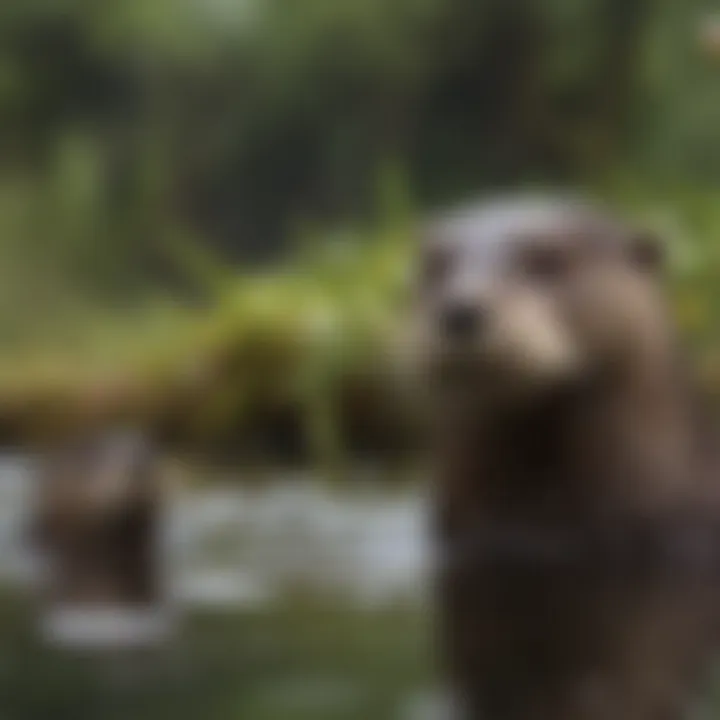
In summary, the ecological role of river otters is multifaceted. From soil enrichment to community indicators, these creatures demonstrate how interconnected nature is. Protecting river otters not only aids in preserving them but also ensures the continued health of their aquatic habitats.
River Otters and Human Interaction
The relationship between humans and river otters is fraught with complexity and nuances. Understanding this interaction is crucial, particularly concerning conservation efforts and ecological balance. River otters are not only vital to aquatic ecosystems; they also have a significant role in shaping perceptions, either positively or negatively, about wildlife in general. Exploring this relationship uncovers the layers of both conflict and cooperation that can lead to healthier ecosystems and more informed communities.
Perceptions and Misconceptions
When discussing river otters, misconceptions abound. Many people see them solely as playful creatures, frolicking in the water without a care in the world. While they're certainly charming and playful, this oversimplified view can detract from the reality of their struggle for survival in an increasingly urbanized world. For instance, some may think river otters are always thriving in natural settings, but the truth often paints a different picture. Habitat loss, pollution, and hunting pressures can threaten their existence.
- Common Misconceptions:
- River otters are just cute animals without any real impact on ecosystems.
- They can easily adapt to human-altered environments without consequences.
- They are always abundant and not in need of conservation efforts.
It's essential to address these myths through education and outreach. For example, initiatives that highlight otters' ecological importance can transform public perception. When people recognize that river otters help control fish populations and contribute to healthy wetland ecosystems, it may inspire more wildlife-friendly behavior.
Ecotourism and Education
Ecotourism represents a promising avenue through which to foster appreciation for river otters. Engaging with the public offers an opportunity not just to learn about these animals, but to connect their importance in our ecosystems. River otters often become star attractions at wildlife parks and nature reserves, prompting discussions about conservation far beyond their cute appearances.
Some notable aspects include:
- Ecotourism Benefits:
- Educational Programs:
- Encourages conservation in habitats where river otters thrive.
- Generates funding for preservation programs and educational initiatives.
- Provides locals with economic incentives to protect natural resources rather than exploit them.
- Schools and local communities engaging in awareness campaigns can use river otters as a case study to teach about biodiversity.
- Workshops led by wildlife experts that explain the ecological roles of otters can be crucial in changing attitudes.
"Understanding river otters not only enriches our knowledge of these fascinating mammals but also serves as a catalyst for greater involvement in wildlife conservation efforts."
By focusing on the interplay between education, conservation, and responsible ecotourism, communities can cultivate a deeper respect for river otters and the ecosystems they inhabit. In doing so, they help to dislodge negative perceptions, replace myths with facts, and instill a sense of responsibility towards nature.
In summary, addressing human interactions with river otters requires an incisive look at perceptions and the transformative potential of ecotourism and education. As we navigate these relationships, understanding our role in their future becomes ever more critical.
River Otters in Different Cultures
The presence of river otters in various cultures around the world reveals a fascinating intersection of nature and human imagination. As symbols of playfulness and adaptability, these creatures have carved out unique niches in folklore and conservation narratives. The discussion on river otters in cultural contexts is vital; it presents an opportunity to understand how societies view wildlife and the implications of these perceptions on conservation efforts.
Folklore and Symbolism
In many indigenous cultures, river otters are celebrated as tricksters, embodying cleverness and agility. For instance, in Native American mythology, the otter represents joy and play but also cleverness in problem-solving. This duality is often illustrated in stories where otters outsmart predators or overcome challenges, teaching lessons of resilience and wit. Such narratives not only highlight the otter's physical traits but also emphasize the qualities valued by the cultures telling these stories.
These animals appear in art, dances, and storytelling, often positioned as symbols of happiness and community bonding. The otter as a motif serves to foster a sense of connection to nature and echoes the importance of water bodies in human life. As these stories weave through time, they shape cultural identities, reflecting human experiences with the natural world.
Perhaps the most poignant example of otters influencing culture is evident in regions where they are revered for their role in maintaining healthy aquatic ecosystems. Their presence in folklore underscores the belief that these creatures are not just animals, but vital players in ecological balance—a reflection of the significant impact they have on their habitats.
"When you see an otter playing, pay attention; it's nature's way of reminding us to embrace playfulness in life."
Cultural Perspectives on Conservation
River otters also serve as a focal point in conservation discussions across various cultures. Their role as indicator species—organisms whose well-being reflects the health of their environment—positions them prominently in ecological preservation narratives. In cultures where river otters are prevalent, community-based conservation initiatives often emerge, driven by the recognition of the otter's dependence on clean, sustainable environments.
In some regions, conservationists have embraced the river otter as a flagship species, engaging communities in habitat restoration activities. Local schools might organize otter-themed discussions, pushing younger generations to immerse themselves in wildlife education. This grassroots approach cultivates a deeper understanding of conservation, inviting people not just to protect the otters, but the ecosystems they inhabit.
Moreover, river otters have become powerful ambassadors in addressing broader environmental issues. In places like the Pacific Northwest, their plights correlate with problems of pollution and habitat loss, linking public awareness directly to the welfare of otters. Art and campaigns around these themes often emphasize parallels between human health and wildlife, forging a critical connection that encourages stewardship of the environment.
Future Research Directions
This segment delves into the vital area of future research focusing on river otter behavior. As habitats continue to evolve due to climate change, pollution, and human encroachment, understanding the adaptive strategies of otters becomes increasingly important. Future studies can enlighten conservation techniques, ensuring that these fascinating creatures thrive in their natural environments. The significance of ongoing research cannot be overstated; it offers insights that could shape effective conservation policies.
Emerging Studies in Otter Behavior
Research on river otters has evolved tremendously. Scientists are now employing a multidisciplinary approach, combining ecology with behavioral science to investigate how these animals adapt to varying environments. Recent studies have concentrated on how otters modify their hunting techniques based on prey availability and environmental conditions. For example, some researchers have noted that otters in regions experiencing lower water levels tend to diversify their diets, indicating a remarkable flexibility in behavior.
Additionally, studies utilizing motion-sensitive cameras and GPS collars have allowed researchers to gather real-time data on otter movement and social interactions, providing a clearer picture of their daily lives.
The implications of these studies stretch far beyond mere observation:
- Conservation strategies can be fine-tuned based on new behavioral data.
- Understanding otter impacts on their ecosystems can guide habitat restorations.
- Insights gained can influence policies aimed at mitigating human-wildlife conflicts or sustaining local fish populations.
Technological Advances in Research
Advances in technology have undeniably revolutionized wildlife research. In the case of river otters, tools like remote sensing and bioacoustics have propelled studies into uncharted waters. With the rise of drone technology, researchers can now monitor otter populations over large areas without intruding on their natural behaviors.
Furthermore, bioacoustic monitoring allows scientists to listen in on the vocalizations of otters, studying trends in communication behaviors that were previously inaccessible. This technology not only enhances understanding of individual species interactions but also opens pathways to studying underwater soundscapes that influence otter habitats.
"With each new technological advancement, the depth of our understanding of river otter behavior keeps widening, leading to more effective conservation strategies."
The integration of these advancements underscores the importance of collaboration within the scientific community. As ethologists work alongside conservation technologists, they cultivate a rich landscape for future research, ensuring that river otters continue to flourish in the face of rapid environmental change.
Finale
The study of river otter behavior is not merely an intellectual exercise or a quaint academic pursuit; it carries significant implications for our understanding of ecosystem dynamics and conservation strategies. River otters, as integral players in their aquatic habitats, exhibit behaviors that reflect their adaptability and essential roles within these ecosystems. By analyzing their social structures, communication methods, and interactions with the environment, one can appreciate the complexities of nature and the interconnectedness of species.
In synthesizing the findings from previous sections of the article, it becomes abundantly clear that river otters possess remarkable abilities that enable them to thrive in changing conditions. Their foraging techniques, social play, and even their response to pollution highlight the resilience and challenges faced by wildlife today. Each of these factors reinforces the need for improved conservation efforts, as understanding the delicate dance of behaviors not only enriches our knowledge but also enables us to protect these creatures effectively.
"The more we know about river otters, the better we can appreciate and protect their homes."
Summary of Key Findings
Throughout this exploration, several key insights into river otter behavior have emerged:
- Social Structure: River otters often form cohesive family units, reinforcing social bonds through playful interactions, which serve both a social and learning function.
- Communication: Their communication methods encompass a range of vocalizations and body language, crucial for maintaining group cohesion and coordinating hunting activities.
- Hunting and Feeding: River otters employ varied foraging techniques that demonstrate intelligence and adaptability, choosing prey based on seasonal availability and environmental changes.
- Reproductive Practices: Their mating rituals and parental care strategies illustrate a commitment to offspring survival, showcasing the importance of nurturing in their lifecycle.
- Influence of External Factors: The effects of climate variability and habitat loss are evident in otter behaviors, underscoring the need for conservation attention to preserve their habitats.
Implications for Conservation and Research
The insights gathered from this comprehensive examination highlight several pivotal considerations regarding conservation and future research:
- Ecosystem Indicators: River otters serve as indicator species; changes in their populations can signify shifts in ecosystem health, urging proactive strategies in conservation efforts.
- Conservation Strategies: Understanding their behaviors allows conservationists to tailor protection methods that address the specific needs and vulnerabilities of river otters, enhancing their survival rates.
- Research Advancements: Emerging studies in otter behavior can benefit from technological advances, such as tracking devices and ecological modeling, leading to more informed conservation decisions.
- Public Awareness: Increasing public awareness about the significance of river otters in their ecosystems can foster community-driven conservation initiatives, linking human activities positively to wildlife protection.
In summary, comprehending the intricate behaviors of river otters not only enriches our appreciation for these mammals but also equips us with the knowledge necessary to ensure their survival and ecological balance. Each behavioral aspect tells a story, shedding light on broader environmental issues and underscoring the necessity for sustainable practices and ongoing research in wildlife conservation.



